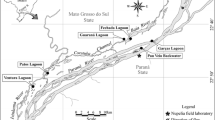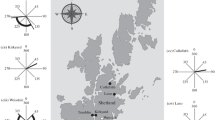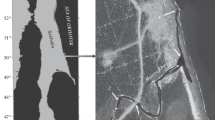Abstract
The upstream migration of four potamodromous salmonid species (brown trout Salmo trutta fario, grayling Thymallus thymallus, Danube salmon Hucho hucho, rainbow trout Oncorhynchus mykiss) through five fish bypass channels in southern Germany was investigated almost daily with fish counting pools from April 2017 to December 2019. In addition, 14 abiotic environmental factors (water temperature, change of the water temperature, discharge, change of the discharge, suspended matter content, change of the suspended matter content, day length, day of the lunar cycle, wind speed, global radiation, air pressure, change of air pressure, fluctuations of the earth’s magnetic field, earth tremors) of the project area were recorded. Using generalized linear models, the environmental factors that significantly affect the ascension rates of the investigated species were determined. In addition, juvenile and adult individuals were considered separately. All significant environmental factors were then evaluated in detail. The individual species react clearly differently to the investigated environmental factors. Especially the ascent rates of grayling and Danube salmon showed strong correlations with water temperature and day length. While high ascent rates of adult individuals were observed mainly during the typical water temperature and season for their spawning season, juvenile individuals were found most frequently in midsummer at high water temperatures. The ascent numbers of rainbow trout showed a much less clear correlation with the environmental factors than the other species considered.

Source: OpenStreet map, 2020; BayernAtlas (https://geoportal.bayern.de/bayernatlas, 2020)







Similar content being viewed by others
Availability of data and material
The datasets generated and analyzed during the current study are not publicly available but are available from the corresponding author on reasonable request.
Ethical approval.
All fish captures and handling were approved by the government of Oberbayern (approval number 55.2–12532-28–2015) in compliance with German laws and regulations. All institutional and national guidelines for the care of animals were followed.
References
Arnekleiv J V, Kraabøl M (1996) Migratory behaviour of adult fast‐growing brown trout (Salmo trutta, L.) In relation to water flow in a regulated Norwegian river. Regulated Rivers: Research & Management 12(1):39–49
Baras E, Lambert H, Philippart JC (1994) A comprehensive assessment of the failure of Barbus barbus spawning migrations through a fish pass in the canalized River Meuse (Belgium). Aquat Living Resour 7(3):181–189
Bash J, Berman C H, Bolton S (2001) Effects of turbidity and suspended solids on salmonids. University of Washington Water Center
Benitez JP, Matondo BN, Dierckx A, Ovidio M (2015) An overview of potamodromous fish upstream movements in medium-sized rivers, by means of fish passes monitoring. Aquat Ecol 49(4):481–497
Bestgen KR, Hawkins JA, White GC, Christopherson KD, Hudson JM, Fuller MH, … Jackson JA (2007) Population status of Colorado pikeminnow in the Green River basin, Utah and Colorado. Trans Am Fish Soc 136(5):1356–1380
Bleisch S, Duckham M, Galton A, Laube P, Lyon J (2014) Mining candidate causal relationships in movement patterns. Int J Geogr Inf Sci 28(2):363–382
Britton JR, Pegg J (2011) Ecology of European barbel Barbus barbus: implications for river, fishery, and conservation management. Rev Fish Sci 19(4):321–330
Bunt CM, Van Poorten BT, Wong L (2001) Denil fishway utilization patterns and passage of several warmwater species relative to seasonal, thermal and hydraulic dynamics. Ecol Freshw Fish 10(4):212–219
Bunt CM, Katopodis C, McKinley RS (1999) Attraction and passage efficiency of white suckers and smallmouth bass by two Denil fishways. North Am J Fish Manag 19(3):793–803
Calles O, Greenberg L (2009) Connectivity is a two-way street—the need for a holistic approach to fish passage problems in regulated rivers. River Res Appl 25(10):1268–1286
Crook DA, Macdonald JI, Morrongiello JR, Belcher CA, Lovett D, Walker A, Nicol SJ (2014) Environmental cues and extended estuarine residence in seaward migrating eels (Anguilla australis). Freshw Biol 59(8):1710–1720
Cunjak RA, Roussel JM, Gray MA, Dietrich JP, Cartwright DF, Munkittrick KR, Jardine TD (2005) Using stable isotope analysis with telemetry or mark-recapture data to identify fish movement and foraging. Oecologia 144(4):636–646
Dedual M, Jowett IG (1999) Movement of rainbow trout (Oncorhynchus mykiss) during the spawning migration in the Tongariro River, New Zealand. NZ J Mar Freshwat Res 33(1):107–117
Dodd JR, Cowx IG, Bolland JD (2017) Efficiency of a nature-like bypass channel for restoring longitudinal connectivity for a river-resident population of brown trout. J Environ Manag 204:318–326
Elliott J M (1981) Some aspects of thermal stress on freshwater teleosts. Stress Fish 209–245
Geist J (2011) Integrative freshwater ecology and biodiversity conservation. Ecol Ind 11(6):1507–1516
Haro A, Kynard B (1997) Video evaluation of passage efficiency of American shad. North Am J Fish Manag 17:981–987
Hayes F R (1953) Artificial freshets and other factors controlling the ascent and population of Atlantic salmon in the La Have River, Nova Scotia. Fisheries Research Board of Canada
Hentig HV (1923) Reactions of animals to changes in physical environment. J Comp Psychol 3(1):61–71
Hilty JA, Lidicker WZ Jr, Merenlender AM (2012) Corridor ecology: the science and practice of linking landscapes for biodiversity conservation. Island Press
Horká P, Horký P, Randák T, Turek J, Rylková K, Slavík O (2015) Radio-telemetry shows differences in the behaviour of wild and hatchery-reared European grayling Thymallus thymallus in response to environmental variables. J Fish Biol 86(2):544–557
Horký P, Slavík O, Bartoš L, Kolářová J, Randák T (2006) The effect of the moon phase and seasonality on the behaviour of pikeperch in the Elbe River. Folia Zool 55(4):411–417
Huntsman AG (1948) Freshets and fish. Trans Am Fish Soc 75(1):257–266
Ihut A M, Zitek A, Weiss S, Ratschan C, Holzer G, Kaufmann T, Cocan D, Constantinescu R Miresan V (2014) Danube salmon (Hucho hucho) in Central and South Eastern Europe: A review for the development of an international program for the rehabilitation and conservation of Danube salmon populations. Bulletin of University of Agricultural Sciences and Veterinary Medicine Cluj-Napoca. Anim Sci Biotechnol 71(2):86–101
Jensen A J, Aass P (1995) Migration of a fast‐growing population of brown trout (Salmo trutta L.) through a fish ladder in relation to water flow and water temperature. Regulat Rivers: Res Manag 10(2‐4):217–228
Jungwirth M (1996) Bypass channels at weirs as appropriate aids for fish migration in rhithral rivers. Regul Rivers: Res Manage 12(4–5):483–492
Kim JO, Ferree GD Jr (1981) Standardization in causal analysis. Sociol Methods Res 10(2):187–210
Kuparinen A, Klefoth T, Arlinghaus R (2010) Abiotic and fishing-related correlates of angling catch rates in pike (Esox lucius). Fish Res 105(2):111–117
Kotusz J, Witkowski A, Baran M, Blachuta J (2006) Fish migrations in a large lowland river (Odra R., Poland)-based on fish pass observations. Folia Zool 55(4):386
Larinier M (2001) Environmental issues, dams and fish migration. FAO Fish Tech Pap 419:45–89
Lucas MC, Baras E (2001) Migration of freshwater fishes, vol 47. Blackwell Science, Oxford
Lucas MC (2000) The influence of environmental factors on movements of lowland-river fish in the Yorkshire Ouse system. Sci Total Environ 251:223–232
Meldgaard T, Nielsen EE, Loeschcke V (2003) Fragmentation by weirs in a riverine system: a study of genetic variation in time and space among populations of European grayling (Thymallus thymallus) in a Danish river system. Conserv Genet 4(6):735–747
Mueller M, Pander J, Geist J (2011) The effects of weirs on structural stream habitat and biological communities. J Appl Ecol 48(6):1450–1461
Muhlfeld CC, McMahon TE, Belcer D, Kershner JL (2009) Spatial and temporal spawning dynamics of native westslope cutthroat trout, Oncorhynchus clarkii lewisi, introduced rainbow trout, Oncorhynchus mykiss, and their hybrids. Can J Fish Aquat Sci 66(7):1153–1168
Northcote T G (1984) Mechanisms of fish migration in rivers. Mech Migr Fish 317–355
O’Hara RB, Kotze DJ (2010) Do not log-transform count data. Methods Ecol Evol 1(2):118–122
Ovidio M, Baras E, Goffaux D, Birtles C, Philippart J C (1998) Environmental unpredictability rules the autumn migration of brown trout (Salmo trutta L.) in the Belgian Ardennes. Adv Invertebr Fish Telem 263–274
Ovidio M, Parkinson D, Sonny D, Philippart JC (2004) Spawning movements of European grayling Thymallus thymallus in the River Aisne (Belgium). Folia Zool 53(1):87
Pander J, Mueller M, Geist J (2013) Ecological functions of fish bypass channels in streams: migration corridor and habitat for rheophilic species. River Res Appl 29(4):441–450
Parkinson D, Philippart JC, Baras E (1999) A preliminary investigation of spawning migrations of grayling in a small stream as determined by radio-tracking. J Fish Biol 55(1):172–182
Pasquaud S, Vasconcelos RP, França S, Henriques S, Costa MJ, Cabral H (2015) Worldwide patterns of fish biodiversity in estuaries: effect of global vs. local factors. Estuar Coast Shelf Sci 154:122–128
Piecuch J, Lojkásek B, Lusk S, Marek T (2007) Spawning migration of brown trout, Salmo trutta in the Morávka reservoir. Folia Zool 56(2):201
Poisson F, Gaertner JC, Taquet M, Durbec JP, Bigelow K (2010) Effects of lunar cycle and fishing operations on longline-caught pelagic fish: fishing performance, capture time, and survival of fish. Fish Bull 108(3):268–281
Prchalová M, Slavík O, Bartoš L (2006) Patterns of cyprinid migration through a fishway in relation to light, water temperature and fish circling behaviour. Int J River Basin Manag 4(3):213–218
Prignon C, Micha J C, Gillet A (1998) Biological and environmental characteristics of fish passage at the tailfer dam in the Meuse River, Belgium. Fish Migr Fish bypasses 69–84
Ripley B, Venables B, Bates D M, Hornik K, Gebhardt A, Firth D (2019) Package ‘mass’ Cran R 538
Rustadbakken A, L’Abée-Lund JH, Arnekleiv JV, Kraabøl M (2004) Reproductive migration of brown trout in a small Norwegian river studied by telemetry. J Fish Biol 64(1):2–15
Sakamoto Y, Ishiguro M, Kitagawa G (1986) Akaike information criterion statistics. Dordrecht The Netherlands D. Reidel 81
Santos JM, Ferreira MT, Godinho FN, Bochechas J (2002) Performance of fish lift recently built at the Touvedo Dam on the Lima River, Portugal. J Appl Ichthyol 18(2):118–123
Santos JM, Ferreira MT, Godinho FN, Bochechas J (2005) Efficacy of a nature-like bypass channel in a Portuguese lowland river. J Appl Ichthyol 21(5):381–388
Schmidt RE, O’Reilly CM, Miller D (2009) Observations of American eels using an upland passage facility and effects of passage on the population structure. North Am J Fish Manag 29(3):715–720
Secor DH, Kerr LA (2009) Lexicon of life cycle diversity in diadromous and other fishes. Am Fish Soc Symp 69:537–556
Slavík O, Horký P, Randák T, Balvín P, Bílý M (2012) Brown trout spawning migration in fragmented central European headwaters: effect of isolation by artificial obstacles and the moon phase. Trans Am Fish Soc 141(3):673–680
Slavík O, Horký P, Bartoš L (2009) Occurrence of cyprinids in fish ladders in relation to flow. Biologia 64(5):999–1004
Slavík O, Bartoš L (2002) Factors affecting migrations of burbot. J Fish Biol 60(4):989–998
Stein F, Doering-Arjes P, Fladung E, Brämick U, Bendall B, Schröder B (2016) Downstream migration of the European eel (Anguilla anguilla) in the Elbe River, Germany: movement patterns and the potential impact of environmental factors. River Res Appl 32(4):666–676
Svendsen JC, Koed A, Aarestrup K (2004) Factors influencing the spawning migration of female anadromous brown trout. J Fish Biol 64(2):528–540
Walker MM, Diebel CE, Haugh CV, Pankhurst PM, Montgomery JC, Green CR (1997) Structure and function of the vertebrate magnetic sense. Nature 390(6658):371
Vøllestad LA, Jonsson B, Hvidsten NA, Naesje TF, Haraldstad Ø, Ruud-Hansen J (1986) Environmental factors regulating the seaward migration of European silver eels (Anguilla anguilla). Can J Fish Aquat Sci 43(10):1909–1916
Acknowledgements
This paper has been written within the projects “Geschiebemanagement an der Iller” (2015-2016) and “Fischzählung an der Iller” (2020) which has been funded by the LEW Wasserkraft GmbH and the EU LIFE Project ISOBEL (Integrated Solutions for BEd Load management, LIFE15 ENV/DE/000162, 2016-2019).
Author information
Authors and Affiliations
Corresponding author
Ethics declarations
Conflict of interest
The authors declare no competing interests.
Additional information
Publisher's Note
Springer Nature remains neutral with regard to jurisdictional claims in published maps and institutional affiliations.
Rights and permissions
About this article
Cite this article
Epple, T., Friedmann, A., Wetzel, KF. et al. The migration of four salmonid species through fish bypass channels depending on environmental factors. Environ Biol Fish 105, 2099–2117 (2022). https://doi.org/10.1007/s10641-022-01233-9
Received:
Accepted:
Published:
Issue Date:
DOI: https://doi.org/10.1007/s10641-022-01233-9




